
Armory Square is a small neighborhood on the west side of Downtown Syracuse, New York. It began life as a busy commercial and industrial area just to the west of the central city. After World War II, Syracuse's central city became less and less populated as more housing and business facilities were built in the suburbs. In the 1980s, plans were first made to transform the languishing district into a small shopping/arts/nightlife district surrounding the former Syracuse Armory. These plans came to fruition during the 1990s, when new stores and restaurants opened, and several new buildings were constructed in a compatible style to the middle and late 1800s and early 1900s architecture dominating the district.

The North Loop is a neighborhood in the Central community of Minneapolis.
S. H. Kress & Co. was the trading name of a chain of five and dime retail department stores in the United States established by Samuel Henry Kress. It operated from 1896 to 1981. In the first half of the 20th century, there were Kress stores with ornamented architecture in hundreds of cities and towns.
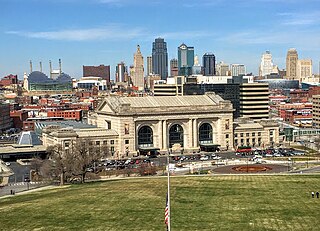
Downtown Kansas City is the central business district (CBD) of Kansas City, Missouri and the Kansas City metropolitan area which contains 3.8% of the area's employment. It is between the Missouri River in the north, to 31st Street in the south; and from the Kansas–Missouri state line eastward to Bruce R. Watkins Drive as defined by the Downtown Council of Kansas City; the 2010 Greater Downtown Area Plan formulated by the City of Kansas City defines the Greater Downtown Area to be the city limits of North Kansas City and Missouri to the north, the Kansas–Missouri state line to the west, 31st Street to the south and Woodland Avenue to the east. However, the definition used by the Downtown Council is the most commonly accepted.
Woodward & Lothrop was a department store chain headquartered in Washington, D.C. that began as the capital's first department store in 1887. Woodies, as it was often nicknamed, maintained stores in the Mid-Atlantic United States. Its flagship store was a fixture of Washington, D.C.'s downtown shopping district, competing with Garfinckel's and acquiring Palais Royal. The chain filed for bankruptcy in January 1994 and completed liquidation in November 1995, with most locations sold to either J. C. Penney or May Department Stores Company. The flagship building is a D.C. historic landmark that became the center of controversy over competing visions for DC's urban renewal after the chain's demise, and the former service warehouse in the city's northeast is also listed as a landmark.

College Park is a shopping mall, residential and office complex on the southwest corner of Yonge and College streets in Toronto, Ontario, Canada.
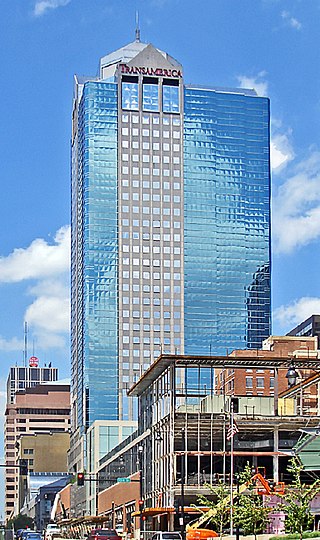
1111 Main is a 38-story, 180.1 m (591 ft) skyscraper at 1111 Main Street on the northeast corner of 12th and Main Streets in Downtown Kansas City, Missouri, around the corner from Oppenstein Brothers Memorial Park. The tower occupies the former site of several retail buildings, including Kline's Department Store and Kresge's Dime Store. The 11-story former Harzfeld's Department Store and the former Boley Building were preserved and have been integrated into the design of 1111 Main.

The Historic Third Ward is a historic warehouse district located in downtown Milwaukee, Wisconsin. This Milwaukee neighborhood is listed on the National Register of Historic Places. Today, the Third Ward is home to over 450 businesses and maintains a strong position within the retail and professional service community in Milwaukee as a showcase of a mixed-use district. The neighborhood's renaissance is anchored by many specialty shops, restaurants, art galleries and theatre groups, creative businesses and condos. It is home to the Milwaukee Institute of Art and Design (MIAD), and the Broadway Theatre Center. The Ward is adjacent to the Henry Maier Festival Park, home to Summerfest. The neighborhood is bounded by the Milwaukee River to the west and south, E. Clybourn Street to the north, and Lake Michigan to the east.

Shockoe Slip is a district in the downtown area of Richmond, Virginia. The name "slip" referred to a narrow passageway leading from Main Street to where goods were loaded and unloaded from the former James River and Kanawha Canal. The rough boundaries of Shockoe Slip include 14th Street, Main Street, Canal Street and 12th Street.
Thomas Brockway Bullene was mayor of Kansas City, Missouri in 1882. He was one of the original owners of the Emery, Bird, Thayer & Co. department store.
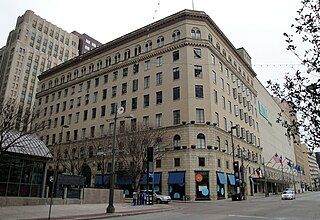
The Titche–Goettinger Building is one of Dallas' original broad-front department stores located along St. Paul Street between Main and Elm Street in downtown Dallas, Texas (USA). The structure currently houses apartments, retail space, and the Universities Center at Dallas. It is listed on the National Register of Historic Places both individually and as a contributing property in the Dallas Downtown Historic District and is a Dallas Landmark as part of the Harwood Street Historic District. It is also located across the street from Main Street Garden Park.

Downtown Norfolk serves as the traditional center of commerce, government, and culture in the Hampton Roads region. Norfolk, Virginia's downtown waterfront shipping and port activities historically played host to numerous and often noxious port and shipping-related uses. With the advent of containerized shipping in the mid-19th century, the shipping uses located on Norfolk's downtown waterfront became obsolete as larger and more modern port facilities opened elsewhere in the region. The vacant piers and cargo warehouses eventually became a blight on downtown and Norfolk's fortunes as a whole. But in the second half of the century, Norfolk had a vibrant retail community in its suburbs; companies like Smith & Welton, High's, Colonial Stores, Goldman's Shoes, Lerner Shops, Hofheimer's, Giant Open Air, Dollar Tree and K & K Toys were regional leaders in their respective fields. Norfolk was also the birthplace of Econo-Travel, now Econo Lodge, one of the nation's first discount motel chains.

The Alexandra is a historic apartment building located on Gilbert Avenue in the Walnut Hills neighborhood of Cincinnati, Ohio, United States. Constructed in 1904 as the neighborhood's first large apartment building, it was one of many such buildings constructed for the real estate management firm of Thomas J. Emery's Sons. It has been named a historic site.
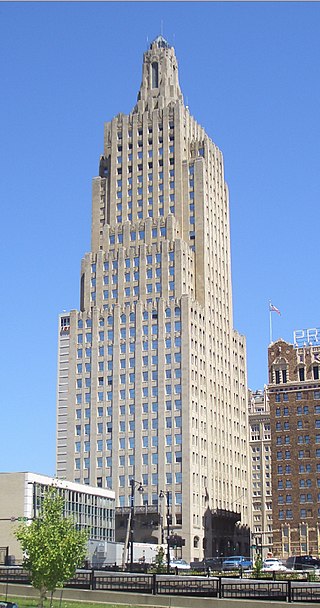
Hoit, Price & Barnes was a prominent Kansas City architectural firm in the early 20th century. It designed several skyscrapers and mansions including three of the current ten tallest buildings in Kansas City; the Kansas City Power and Light Building, 909 Walnut, and Oak Tower.
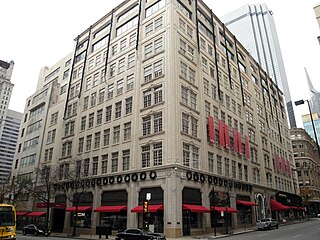
The Neiman Marcus Building is a historic commercial structure located in the Main Street District in downtown Dallas, Texas (USA). It is the corporate headquarters and flagship store of Neiman Marcus. It is the last of the original department stores still serving downtown Dallas. It is listed on the National Register of Historic Places as a contributing property of the Dallas Downtown Historic District.

The Crescent Warehouse Historic District is a 10.5-acre (4.2 ha) historic district in Downtown Davenport, Iowa, United States. The district is a collection of multi-story brick structures that formerly housed warehouses and factories. Most of the buildings have been converted into loft apartments. The district was listed on the National Register of Historic Places in 2003.

The Kansas City Club, founded in 1882 and located in the Library District of Downtown Kansas City, Missouri, USA, was the oldest gentlemen's club in Missouri. The club began admitting women members in 1975. Along with the River Club on nearby Quality Hill, it was one of two surviving private city clubs on the Missouri side of Kansas City. Notable members include Presidents Harry Truman and Dwight D. Eisenhower, General Omar Bradley, and political boss Tom Pendergast. It closed in 2015.
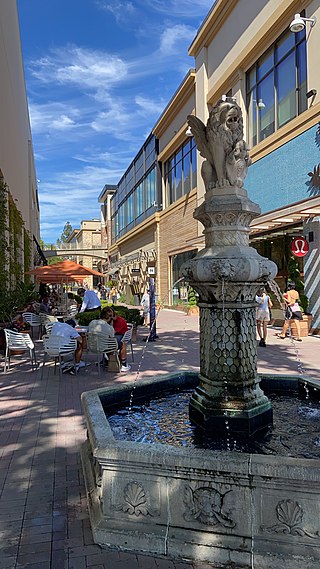
Broadway Plaza is an outdoor shopping mall located in downtown Walnut Creek. The shopping center opened on October 11, 1951 and is owned and operated by Macerich. The mall is anchored by Nordstrom and Macy's, and features nearly 80 stores including Crate & Barrel, flagship H&M and ZARA stores, a standalone Apple store with an adjoining outdoor plaza, an Industrious co-working space, a Life Time Fitness sports club, and a planned Pinstripes entertainment center and restaurant.

Frank M. Howe was an architect in Kansas City, Missouri, and Boston, Massachusetts. He was a partner with Henry Van Brunt in the prominent firm of Van Brunt and Howe. He later partnered with Henry F. Hoit as Howe, Hoit & Cutler.

171-191 South High Street is a pair of historic buildings in Downtown Columbus, Ohio. The commercial structures have seen a wide variety of retail and service uses through the 20th century, including shoe stores, groceries, opticians, hatters, jewelers, a liquor store, and a car dealership. Both exhibit early 20th century façades; 185-191 South High was constructed in 1906, while 171-177 South High was constructed sometime in the 19th century and was remodeled in the second decade of the 20th century. The latter building was once part of the Lazarus Block, holding the original Lazarus department store. The store grew to encompass a group of seven buildings on the site until it moved to the Lazarus Building in 1909. The same building was again noted in the 1930s, for housing the first Kroger store in Downtown Columbus, which was considered the first supermarket in the city. The buildings, the nearby Ohio National Bank building, and a garage building were sold to a development company in 2023. The developer plans to renovate the bank building and demolish all other structures on the block. In June 2023 the buildings were placed on the Columbus Landmarks Foundation's Most Endangered List.

















